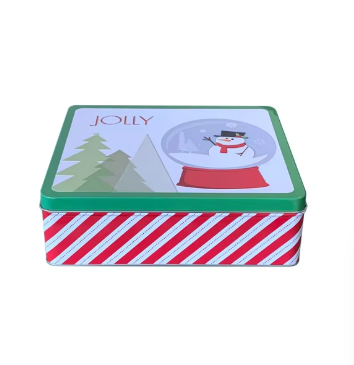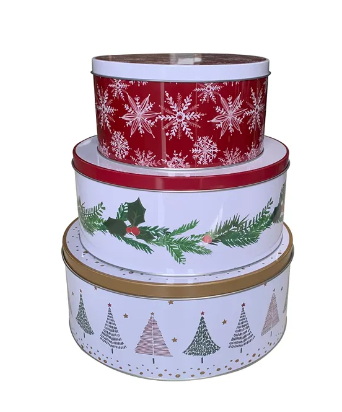Pratęskite asmeninės skardinės gyvavimo laiką naudodami tinkamą priežiūrą
A personalizavimo sklypas tarnauja ne tik kaip pakuotė – tai gali būti suvenyras, saugojimo indas ar net dekoratyvinis eksponatas. Ar tai dovanų dėžutė, reklaminis daiktas ar prekybos produktas, svarbu palaikyti asmeninę skardinę puikoje būklėje, kad ji toliau kurtų vertę ilgai po pirmojo naudojimo. Norint apsaugoti tiek išvaizdą, tiek funkcionalumą, būtina nuolatinė priežiūra ir protingas elgesys.
Supraskite savo skardinės medžiagas ir dengiamąjį sluoksnį
Dažniausiai naudojamos medžiagos asmeninėse skardinėse
Daugelis personalizuotų dėžučių yra pagamintos iš cinkuoto plieno lakšto – plono plieno lakšto, padengto cinko sluoksniu. Ši medžiaga yra žinoma dėl savo stiprumo, atsparumo korozijai ir dekoravimo patogumo. Priklausomai nuo numatytos paskirties, jūsų dėžutė taip pat gali turėti vidinius sluoksnis, pvz., maistui saugų laką, arba išorinius apsauginius sluoksnis, tokius kaip lakuas arba miltelinis dažas.
Kodėl svarbu paviršiaus apdaila
Išorinė apdaila ne tik padeda pagerinti išvaizdą, bet ir apsaugo paviršių nuo įbrėžimų, pirštų atspaudų ir rūdžių. Blizgantys paviršiai labiau linkę prie dėmių, tačiau suteikia gyvesnį išvaizdos efektą. Matiniai sluoksniai geriau maskuoja pirštų atspaudus, tačiau, jei nesisaugoma, gali būti linkę į nubrozdinimus. Supratus jūsų dėžutės apdailą, galima pasirinkti tinkamą valymo ir priežiūros metodą.
Kaip saugiai valyti personalizuotą dėžutę
Pagrindiniai valymo metodai
Norėdami išvalyti personalizuotą skardinę, pradėkite nuo minkštos sausos medžiagos, kad pašalintumėte dulkes ir laisvai besilaikančias daleles. Jei reikia kruopštesnio valymo, naudokite šiek tiek drėgną mikropluošto medžiagą su švelniu muilu ir vandeniu. Venkite abrazyvinių valiklių arba šveitimo kilpelių, nes jie gali sugadinti spausdintus dizainus, dengiančias medžiagas arba išgaubtus elementus. Minkštai nuvalykite ratine kryptimi ir nedelsdami nusausinkite švaria rankšluosčiu.
Maisto likučių ar lipnių medžiagų valymas
Jei skardinė buvo naudojama maistui ar lipniems daiktams, tokiems kaip saldainiai, naudokite šiltą vandenį ir švelnų indų plovimo muilą, kad išmirkytumėte likučius. Neskandinkite visos skardinės vandenyje, nebent ji aiškiai pažymėta kaip vandeniui atspari. Vietinis valymas naudojant neabrazyvinį spongą paprastai yra pakankamas. Prieš saugojimą visada įsitikinkite, kad skardinė yra visiškai sausa, kad išvengtumėte rūdžių ar pelėsio atsiradimo.
Apsaugininkas nuo aplinkos ir naudojimo sukeltų pažeidimų
Idealios saugojimo sąlygos
Asmeninius dėžutes laikykite vėsioje, sausoje vietoje, atokiai nuo tiesioginės saulės šviesos ir didelės drėgmės. Ilgas drėgmės poveikis gali sukelti rūdijimą, o saulės šviesa gali išblukti spausdintus dizainus arba nudažyti dengiančias medžiagas. Jei dėžutės laikomos ilgą laiką, jas laikykite apsauginėse dėklų arba medvilniniuose maišuose, kad išvengtumėte įbrėžimų ir kontaktinio pažeidimo.
Venkite fizinio pažeidimo
Dėžutės, nukritusios, įspaustos arba ant jų padėtos sunkios kroviniai gali deformuoti jų formą arba sugadinti sandarumą. Dėžutėms su vyriais arba glaudžiai prigludusiais dangteliais, pernelyg didelė jėga gali sutrikdyti uždarymo mechanizmą arba sugadinti vyrius. Ypač atsargiai elkitės su dekoratyvinėmis arba limituotomis leidimo dėžutėmis.

Išlaikykite vizualinį patrauklumą laikui bėgant
Blizgesio ir švytėjimo atkūrimas
Laikui bėgant dėžutės gali prarasti blizgesį. Norėdami atkurti švelnų blizgesį, ant minkštos medžiagos tepkite nedidelį kiekį metalui tinkamo poliravimo priemonės. Prieš poliruodami visą paviršių, atlikite bandomąjį testą, ypač dėžutėms su spausdintomis grafikomis. Venkite poliruoti matinius arba dažytus paviršius, nebent gamintojas to rekomenduoja.
Išsaugant spausdintus dizainus ir reljefą
Dizaino elementai, tokie kaip logotipai, raštai ir reljefas, dėl dažno naudojimo linkę nublukti. Kai įmanoma, laikykite dėžutę iš šonų, kad išvengtumėte tiesioginio kontakto su spausdintomis detalėmis. Jei dizainas pradeda blukti, įtraukite dėžutę į kolekciją, o ne kasdieninio naudojimo daiktą, kad išlaikytumėte jos estetinę vertę.
Geriausios praktikos ilgalaikiam naudojimui
Pakartotinė panaudojimo kryptis išsaugant originalią būklę
Daugelis žmonių pakartotinai naudoja individualizuotos skardinės arbatai, biuro reikmenims, monetoms ar siuvimo rinkiniams laikyti. Pakartotinai naudojant, vidų apsiūkite medžiaga arba popieriumi, kad apsaugotumėte tiek dėžutę, tiek jos turinį. Venkite skysčių, aliejinės konsistencijos produktų ar labai rūgščių daiktų laikymo, nebent dėžutė yra maisto pramonės standartams atitinkanti ir atspari korozijai.
Eksponatų keitimas rotacijos būdu
Jei naudojate dėžutes kaip namų ar parduotuvių dekoracijos dalį, retkarčiais jas pasukite, kad sumažėtų išblukimas nuo nuolatinės šviesos. Periodiškai nuvalykite dulkes ir apžiūrėkite, kad laiku pastebėtumėte bet kokius pažeidimus. Įtraukę šias įpročius į savo kasdienybę, jūsų asmeninė dėžutė ilgam laikui išliks nauja.
DUK
Ar galiu plauti asmeninę dėžutę indaplovėje?
Paprastai ne. Indaplovės naudoja aukštą temperatūrą ir agresyvius ploviklius, kurie gali pažeisti dėžutės sluoksnį, ją deformuoti arba sukelti išblukimą. Plauti rankomis su švelniu muilu yra visada rekomenduojama, nebent gamintojas nurodo, kad dėžutė yra tinkama indaplovei.
Ką daryti, jei dėžutėje atsirado rūdžių?
Jei atsiranda rūdžių, švelniai nubruožkite paveiktą vietą minkšta šepele ir kepimo miltelių pasta, tada nuvalykite. Po to ant tepkite nedidelį kiekį bespalvio lako arba metalo apsaugos priemonės. Jei rūdys plitos visoje dėžutėje, apsvarstykite galimybę ją išimti iš kasdieninio naudojimo ir panaudoti kaip dekoratyvinį elementą.
Ar saugu ilgalaikėms maisto produkto laikymui asmeninėje dėžutėje?
Tik jei dėžutė pažymėta kaip maisto saugi ir turi maisto klasės apsauginį sluoksnį. Arbatai, sausainiams ar prieskoniams visada įsitikinkite, kad dėžutė švari, sausa ir sandariai uždaryta. Venkite ilgai laikyti greitai gendantžių daiktų, nes dėžutės nėra sandarios, nebent jos sukurtos tam tikslui.
Kaip pašalinti kvapus iš dėžutės vidinės dalies?
Į dėžutę įdėkite mažą puodelį su kepimo soda arba maišelį su aktyvuotu anglis ir uždarykite 24–48 valandų. Šie natūralūs kvapų naikintuvai sugeria likusius kvapus, nesugadindami vidinio sluoksnio. Po to visada nuplaukite dėžutę ir išleiskite kvapą prieš vėl naudodami ją saugojimui.
Turinio lentelė
- Pratęskite asmeninės skardinės gyvavimo laiką naudodami tinkamą priežiūrą
- Supraskite savo skardinės medžiagas ir dengiamąjį sluoksnį
- Kaip saugiai valyti personalizuotą dėžutę
- Apsaugininkas nuo aplinkos ir naudojimo sukeltų pažeidimų
- Išlaikykite vizualinį patrauklumą laikui bėgant
- Geriausios praktikos ilgalaikiam naudojimui
- DUK

 EN
EN
 AR
AR BG
BG HR
HR CS
CS DA
DA NL
NL FI
FI FR
FR DE
DE EL
EL IT
IT JA
JA KO
KO NO
NO PL
PL PT
PT RO
RO RU
RU ES
ES SV
SV CA
CA IW
IW ID
ID LV
LV LT
LT SR
SR SK
SK SL
SL UK
UK VI
VI SQ
SQ HU
HU TR
TR FA
FA MS
MS GA
GA CY
CY LA
LA